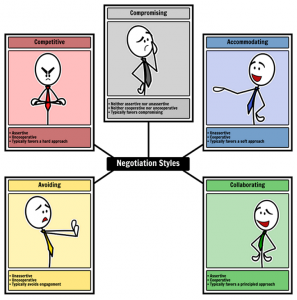Negotiation Styles
People often ask “which is the best negotiation style?” As with much management theory there is no single ‘best’ or ‘right’ approach. All five profiles of dealing with conflict are useful in different situations. Although we’re capable of using all five, most of us tend to have one or two preferred negotiation conflict styles that we use unconsciously in most conflict situations. Why? Either because our preferred styles have worked for us in the past, or because of our temperament (nature) or because of our upbringing (nurture).
1. Compete (I win – You lose)
- These types of negotiators are concerned with achieving their own goals without evaluating the impact on others.
- Use various manipulative tactics such as attacks, threats, and other aggressive behavior to achieve their objectives
- Effective when results are needed quickly and long term relationship is not important.
- They are strategic thinkers therefore have very little time for pleasantries.
- Example – buying a new car or a lawyer representing their client or commodity based selling.
2. Accommodate (I Lose – You Win)
- Focus on preventing relationships and building rapport
- Often concessions are easily given in hope of making the relationship stronger
- Own needs are neglected in favour of helping the other side get what they want
- Negotiators believe that the only way to ultimately get what they want is to give everything to the other party
- Examples of this style are when a person knowingly injures another person and willingly offers to pay all medical expenses hoping the injured party does not sue.
3. Avoid (I Lose – You Lose)
- Primarily concerned in avoiding situations that may result in conflict as they find them intimidating and stressful by staying behind the scenes of a negotiation.
- Characterized by sidestepping, postponing, and ignoring the issue or situation
- Best in situations where the investment of time to resolve the issue outweighs the outcome of the discussion.
- Not focused on either the substance of the agreement or the relationship.
4. Compromise (I Lose / Win Some – You Lose / Win Some)
- Negotiator acknowledges that there is a loss but it is better to compromise than to completely lose
- This style falls between accommodating and competing
- Requires concessions from both sides to find agreement
- Does not focus on legitimate or fair standards for settlement and instead utilizes “Meet in the middle,” or “Split the difference” solutions
- Common when the negotiating parties have a high level of trust between each other and are time poor.
5. Collaborate (I Win – You Win)
- Focuses on using problem solving methods to create value and discover mutually satisfactory agreements
- Utilizes the creativity of both parties to find solutions to both sides’ interests
- Tend to be assertive about their needs and cooperative with the other side
- Effective when long term relationship is important and short term task is important
- An example of this style is Honda Motor Company which is known for being completely focused on a collaborative approach to working with their suppliers resulting in greater commitment and cooperation and well built cars!
Apply for Negotiation Manager Certification Now!!
https://www.vskills.in/certification/life-skills/negotiation-manager-certification


